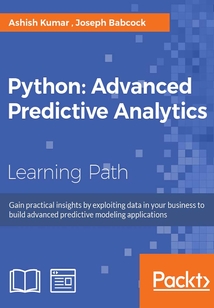舉報 

會員
Python:Advanced Predictive Analytics
最新章節:
Index
Thisbookisdesignedforbusinessanalysts,BIanalysts,datascientists,orjuniorleveldataanalystswhoarereadytomoveonfromaconceptualunderstandingofadvancedanalyticsandbecomeanexpertindesigningandbuildingadvancedanalyticssolutionsusingPython.IfyouarefamiliarwithcodinginPython(orsomeotherprogramming/statistical/scriptinglanguage)buthaveneverusedorreadaboutpredictiveanalyticsalgorithms,thisbookwillalsohelpyou.
目錄(130章)
倒序
- 封面
- 版權信息
- Credits
- Preface
- Part 1. Module 1
- Chapter 1. Getting Started with Predictive Modelling
- Introducing predictive modelling
- Applications and examples of predictive modelling
- Python and its packages – download and installation
- Python and its packages for predictive modelling
- IDEs for Python
- Summary
- Chapter 2. Data Cleaning
- Reading the data – variations and examples
- Various methods of importing data in Python
- The read_csv method
- Use cases of the read_csv method
- Case 2 – reading a dataset using the open method of Python
- Case 3 – reading data from a URL
- Case 4 – miscellaneous cases
- Basics – summary dimensions and structure
- Handling missing values
- Creating dummy variables
- Visualizing a dataset by basic plotting
- Summary
- Chapter 3. Data Wrangling
- Subsetting a dataset
- Generating random numbers and their usage
- Grouping the data – aggregation filtering and transformation
- Random sampling – splitting a dataset in training and testing datasets
- Concatenating and appending data
- Merging/joining datasets
- Summary
- Chapter 4. Statistical Concepts for Predictive Modelling
- Random sampling and the central limit theorem
- Hypothesis testing
- Chi-square tests
- Correlation
- Summary
- Chapter 5. Linear Regression with Python
- Understanding the maths behind linear regression
- Making sense of result parameters
- Implementing linear regression with Python
- Model validation
- Handling other issues in linear regression
- Summary
- Chapter 6. Logistic Regression with Python
- Linear regression versus logistic regression
- Understanding the math behind logistic regression
- Implementing logistic regression with Python
- Model validation and evaluation
- Model validation
- Summary
- Chapter 7. Clustering with Python
- Introduction to clustering – what why and how?
- Mathematics behind clustering
- Implementing clustering using Python
- Fine-tuning the clustering
- Summary
- Chapter 8. Trees and Random Forests with Python
- Introducing decision trees
- Understanding the mathematics behind decision trees
- Implementing a decision tree with scikit-learn
- Understanding and implementing regression trees
- Understanding and implementing random forests
- Summary
- Chapter 9. Best Practices for Predictive Modelling
- Best practices for coding
- Best practices for data handling
- Best practices for algorithms
- Best practices for statistics
- Best practices for business contexts
- Summary
- Appendix A. A List of Links
- Part 2. Module 2
- Chapter 1. From Data to Decisions – Getting Started with Analytic Applications
- Designing an advanced analytic solution
- Case study: sentiment analysis of social media feeds
- Case study: targeted e-mail campaigns
- Summary
- Chapter 2. Exploratory Data Analysis and Visualization in Python
- Exploring categorical and numerical data in IPython
- Time series analysis
- Working with geospatial data
- Introduction to PySpark
- Summary
- Chapter 3. Finding Patterns in the Noise – Clustering and Unsupervised Learning
- Similarity and distance metrics
- Affinity propagation – automatically choosing cluster numbers
- k-medoids
- Agglomerative clustering
- Streaming clustering in Spark
- Summary
- Chapter 4. Connecting the Dots with Models – Regression Methods
- Linear regression
- Tree methods
- Scaling out with PySpark – predicting year of song release
- Summary
- Chapter 5. Putting Data in its Place – Classification Methods and Analysis
- Logistic regression
- Fitting the model
- Evaluating classification models
- Separating Nonlinear boundaries with Support vector machines
- Comparing classification methods
- Case study: fitting classifier models in pyspark
- Summary
- Chapter 6. Words and Pixels – Working with Unstructured Data
- Working with textual data
- Principal component analysis
- Images
- Case Study: Training a Recommender System in PySpark
- Summary
- Chapter 7. Learning from the Bottom Up – Deep Networks and Unsupervised Features
- Learning patterns with neural networks
- The TensorFlow library and digit recognition
- Summary
- Chapter 8. Sharing Models with Prediction Services
- The architecture of a prediction service
- Clients and making requests
- Server – the web traffic controller
- Persisting information with database systems
- Case study – logistic regression service
- Summary
- Chapter 9. Reporting and Testing – Iterating on Analytic Systems
- Checking the health of models with diagnostics
- Iterating on models through A/B testing
- Guidelines for communication
- Summary
- Bibliography
- Index 更新時間:2021-07-02 20:09:52
推薦閱讀
- Redis使用手冊
- Building Computer Vision Projects with OpenCV 4 and C++
- Python絕技:運用Python成為頂級數據工程師
- Greenplum:從大數據戰略到實現
- 商業分析思維與實踐:用數據分析解決商業問題
- 城市計算
- SQL優化最佳實踐:構建高效率Oracle數據庫的方法與技巧
- Oracle 12c云數據庫備份與恢復技術
- 高維數據分析預處理技術
- SAS金融數據挖掘與建模:系統方法與案例解析
- Python數據分析從小白到專家
- Internet of Things with Python
- MySQL數據庫應用與管理
- Delphi High Performance
- 數據迷霧:洞察數據的價值與內涵
- 精通Neo4j
- 數字孿生
- 商業銀行數據庫管理實踐
- Foxtable數據庫應用開發寶典
- MySQL必知必會
- 算法設計與分析
- 軟件定義數據中心:Windows Server SDDC技術與實踐
- Data Analysis with Python
- MySQL運維進階指南
- 一本書讀懂移動大數據
- SQL語法與范例詳解詞典
- Learning Software Testing with Test Studio
- 數據說服力:菜鳥學數據分析
- 中小銀行運維架構:解密與實戰
- 精益數據分析

